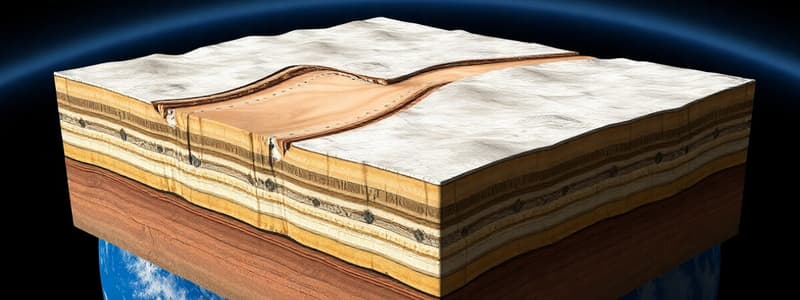Podcast
Questions and Answers
Which geological formation is LEAST likely to be found at a divergent plate boundary?
Which geological formation is LEAST likely to be found at a divergent plate boundary?
- Mid-oceanic ridge
- Coastal mountain range (correct)
- Rift valley
- Volcano
At which type of plate boundary are earthquakes most commonly formed?
At which type of plate boundary are earthquakes most commonly formed?
- Divergent
- Transform Fault (correct)
- Convergent
- Oceanic-Oceanic
What process causes the formation of new lithosphere at mid-ocean ridges?
What process causes the formation of new lithosphere at mid-ocean ridges?
- Transform fault slippage
- Subduction of continental plates
- Erosion from ocean currents
- Magma cooling and solidifying (correct)
In a subduction zone involving an oceanic plate and a continental plate, which plate is typically forced beneath the other?
In a subduction zone involving an oceanic plate and a continental plate, which plate is typically forced beneath the other?
The Himalayas were formed by what type of plate boundary?
The Himalayas were formed by what type of plate boundary?
Which layer of the Earth is best described as a 'soft solid' due to the intense heat from the core?
Which layer of the Earth is best described as a 'soft solid' due to the intense heat from the core?
Island arcs are typically formed at which type of plate boundary?
Island arcs are typically formed at which type of plate boundary?
Which of the following is a primary characteristic of the Earth's inner core?
Which of the following is a primary characteristic of the Earth's inner core?
Flashcards
Earth's Core
Earth's Core
Earth's innermost layer, composed of nickel, iron, and radioactive elements, generating significant heat.
Mantle
Mantle
A soft, solid layer of magma surrounding the Earth's core.
Asthenosphere
Asthenosphere
The solid, flexible outer layer of the mantle, just beneath the lithosphere.
Lithosphere
Lithosphere
Signup and view all the flashcards
Divergent Plate Boundary
Divergent Plate Boundary
Signup and view all the flashcards
Transform Fault Boundary
Transform Fault Boundary
Signup and view all the flashcards
Convergent Plate Boundary
Convergent Plate Boundary
Signup and view all the flashcards
Subduction
Subduction
Signup and view all the flashcards
Study Notes
- The Earth's core comprises a dense mass of nickel, iron, and radioactive elements.
- Radioactive elements release massive amounts of heat.
- The inner core is hot, while the outer core is cold.
- The mantle is a soft solid of magma surrounding the core, kept soft by the core's intense heat.
- The asthenosphere is a solid, flexible outer layer of the mantle, beneath the lithosphere.
- The lithosphere is a thin, brittle layer of rock floating on top of the mantle and is broken up into tectonic plates.
- The crust is the very outer layer of the lithosphere and is the Earth’s surface.
Types of Tectonic Plates
- There are two types of tectonic plates: continental and oceanic
- Continental plates mostly consist of granitic rock.
- Oceanic plates mostly consist of basaltic rock.
Divergent Plate Boundary
- Plates move away from each other at divergent plate boundaries.
- A rising magma plume from the mantle forces plates apart.
- Divergent plate boundaries form mid-oceanic ridges, volcanoes, seafloor spreading, and rift valleys (in land).
Transform Fault Plate Boundary
- Plates slide past each other in opposite directions at transform fault plate boundaries.
- Transform fault plate boundaries form earthquakes.
Convergent Plate Boundary
- Plates move towards each other at convergent plate boundaries.
- Subduction (one plate being forced beneath another) occurs when one plate is oceanic at convergent plate boundaries.
- Convergent plate boundaries form mountains, island arcs, earthquakes, and volcanoes.
Seafloor Spreading
- Magma heated by Earth’s core rises towards the lithosphere.
- Rising magma cools and expands, forcing oceanic plates apart.
- This creates mid-ocean ridges, volcanoes, and spreading zones or “seafloor spreading”.
- Magma cools and solidifies into new lithosphere.
- Spreading magma forces the oceanic plate into a continental plate (subduction zone).
- The sinking oceanic plate melts back into magma.
- This process also forces magma up, creating narrow, coastal mountains on land.
Oceanic-Oceanic Boundary
- At an oceanic-oceanic boundary, one plate subducts underneath the other.
- This process forces magma up to the lithosphere surface, forming mid-ocean volcanoes.
- It also forms island arcs and off-shore trenches.
Oceanic-Continental Boundary
- At an oceanic-continental boundary, the dense oceanic plate subducts beneath the continental plate and melts back into magma.
- This forces magma up to the lithosphere surface, forming coastal mountains (Andes), volcanoes on land, trenches, and tsunamis.
Continental-Continental Boundary
- At a continental-continental boundary, one plate subducts underneath the other, forcing the surface crust upward, creating mountains, such as the Himalayas.
Transform Fault Boundary
- Plates sliding past each other in opposite directions creates a fault (fracture in the rock surface) at a transform fault boundary.
- Earthquakes are the most common activity.
- Earthquakes occur when rough edges of plates get stuck on each other.
- Pressure builds as plates keep sliding, but edges stay stuck.
- When stress overcomes the locked fault, plates suddenly release, slide past each other, and release energy that shakes the lithosphere.
Studying That Suits You
Use AI to generate personalized quizzes and flashcards to suit your learning preferences.




